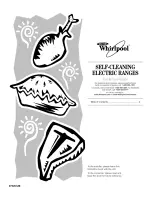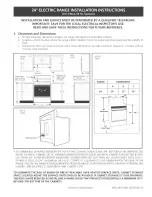
15
Each control has a variable power output from LO to HI with a number of positions in between. The
amount of heat is increased by turning the knob toward HI and decreased by turning the knob toward
LO. The circle in the surface unit graphic above the control shows which surface unit is activated by
that knob.
IMPORTANT: To switch on, always lightly press the control knob, then turn it.
COOKWARE SELECTION
The cooking surface
Your ceramic cook-top is made of an extremely hard and durable material. The surface is scratch
resistant, not scratch proof. Avoid using cookware with ridged bottoms. Ridged pots with dirty or
chipped enamel bottoms may scratch the cook-top if they are pulled across the ceramic surface.
Make sure the cook-top and pot bottoms are clean before cooking. Certain items, particularly sugar
grains or crystallized liquids such as molasses or syrups are actually harder than ceramic and can
scratch the surface if they are not cleaned off immediately. However, small or light scratches will not
affect the safety or performance of the cook-top.
Pots and pans
Special cookware is not required, but as is true with all types of cooking appliances, the better the
cookware, the better the performance.
Following these tips will allow you to make the most of your ceramic cook-top.
For the most even and energy efficient cooking, the diameter of the pots should match the
diameter of the burners as closely as possible.
Use cookware with thick, flat, smooth bottoms. Slightly concave bottoms will also work adequately.
Pans with convex bottoms will not cook well.
Using a lid while cooking will minimize the loss of heat and decrease the cooking time.
Copper bottom and aluminum pans may leave a residue on the cook-top in the form of metallic
lines. This is normal. These lines can be removed using a non-abrasive ceramic cook-top cleaner
or a shielded scraper blade.
Cast iron, glass or stoneware should not be used because they have poor heat transfer and may
scratch the surface.
CAUTION:
Be sure to clean the cook-top after each use. Each time the residue is allowed to melt it
becomes harder to remove and may mar the appearance of the cook-top. Let the cook-top cool
before cleaning.
WARNING
Make sure that the handles of cookware do not stick out over the edge of the range, to
avoid their being knocked over by accident. This also makes it more difficult for children to
reach the cooking pots/pans.






































